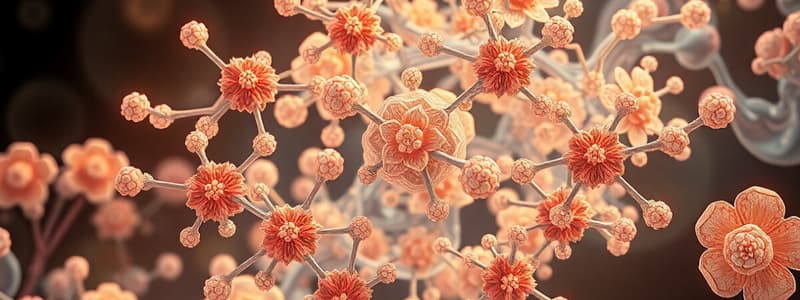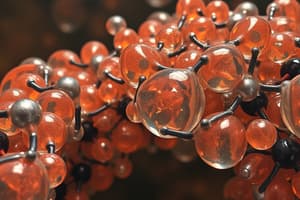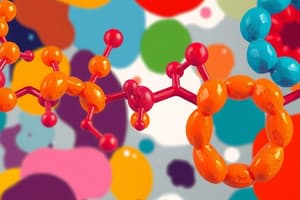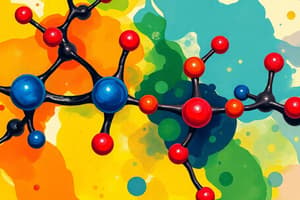Podcast
Questions and Answers
Which of the following is a monomer that can be linked to form a larger macromolecule?
Which of the following is a monomer that can be linked to form a larger macromolecule?
- Glucose
- ATP
- Oleic Acid
- All of the above (correct)
What is the process called where monomers link together to form larger polymers?
What is the process called where monomers link together to form larger polymers?
- Hydrolysis
- Monomerization
- Dehydration synthesis (correct)
- Polymerization
A polymer is formed when...
A polymer is formed when...
- Two or more monomers bond together (correct)
- A molecule gains water
- A molecule loses water
- A monomer is broken down into smaller units
What is the difference between a dimer and a polymer?
What is the difference between a dimer and a polymer?
Which of the following is a type of fatty acid?
Which of the following is a type of fatty acid?
Which of the following is a type of nucleotide?
Which of the following is a type of nucleotide?
Which of the following is an example of a monosaccharide?
Which of the following is an example of a monosaccharide?
What is the main function of ATP (adenosine triphosphate) in cells?
What is the main function of ATP (adenosine triphosphate) in cells?
Which of the following is NOT a characteristic of macromolecules?
Which of the following is NOT a characteristic of macromolecules?
Which of the following is the central unifying principle of pharmacology?
Which of the following is the central unifying principle of pharmacology?
What is the independent variable in the study of pharmacological effects?
What is the independent variable in the study of pharmacological effects?
What is the term used to describe the study of how drugs are absorbed, distributed, metabolized, and eliminated from the body?
What is the term used to describe the study of how drugs are absorbed, distributed, metabolized, and eliminated from the body?
Which of the following is NOT considered an application of pharmacology?
Which of the following is NOT considered an application of pharmacology?
What is the primary focus of pharmacodynamics?
What is the primary focus of pharmacodynamics?
What is the name of the polymer that forms from the monomer glucose?
What is the name of the polymer that forms from the monomer glucose?
What is the process by which a drug is broken down in the body?
What is the process by which a drug is broken down in the body?
Which of the following is NOT a key component of ADME?
Which of the following is NOT a key component of ADME?
Which of the following is a characteristic of an agonist?
Which of the following is a characteristic of an agonist?
Which of the following is an example of a biomolecule?
Which of the following is an example of a biomolecule?
Which branch of pharmacology focuses on the study of natural sources of drugs?
Which branch of pharmacology focuses on the study of natural sources of drugs?
What is the name of the process by which proteins assemble into larger, multi-protein complexes?
What is the name of the process by which proteins assemble into larger, multi-protein complexes?
What is the term used for the interaction between a drug and its target molecule?
What is the term used for the interaction between a drug and its target molecule?
What is the name of a protein that is made up of four different polypeptide chains?
What is the name of a protein that is made up of four different polypeptide chains?
What is the main goal of experimental therapeutics?
What is the main goal of experimental therapeutics?
Which of the following is an example of a lipid monomer?
Which of the following is an example of a lipid monomer?
What is the function of a receptor?
What is the function of a receptor?
Which of the following is an example of a protein domain?
Which of the following is an example of a protein domain?
What is the main difference between an oligomer and a polymer?
What is the main difference between an oligomer and a polymer?
Which of the following is NOT a characteristic of a protein?
Which of the following is NOT a characteristic of a protein?
Flashcards
Monosaccharides
Monosaccharides
Simple sugars like glucose and fructose used for energy.
Glucose
Glucose
A primary energy source for cells, a type of monosaccharide.
Nucleotides
Nucleotides
Building blocks of nucleic acids, including ATP and AMP.
ATP (Adenosine Triphosphate)
ATP (Adenosine Triphosphate)
Signup and view all the flashcards
Fatty Acids
Fatty Acids
Signup and view all the flashcards
Oleic Acid
Oleic Acid
Signup and view all the flashcards
Amino Acids
Amino Acids
Signup and view all the flashcards
Polymerization
Polymerization
Signup and view all the flashcards
Monomer
Monomer
Signup and view all the flashcards
Dimer
Dimer
Signup and view all the flashcards
Oligomer
Oligomer
Signup and view all the flashcards
Polymer
Polymer
Signup and view all the flashcards
Carbohydrates
Carbohydrates
Signup and view all the flashcards
Ligand
Ligand
Signup and view all the flashcards
Receptor
Receptor
Signup and view all the flashcards
Agonist
Agonist
Signup and view all the flashcards
Antagonist
Antagonist
Signup and view all the flashcards
Bradykinin
Bradykinin
Signup and view all the flashcards
Pharmacology
Pharmacology
Signup and view all the flashcards
Independent Variable
Independent Variable
Signup and view all the flashcards
Dependent Variable
Dependent Variable
Signup and view all the flashcards
Concentration-Response Function
Concentration-Response Function
Signup and view all the flashcards
Pharmacodynamics
Pharmacodynamics
Signup and view all the flashcards
Pharmacokinetics
Pharmacokinetics
Signup and view all the flashcards
ADME
ADME
Signup and view all the flashcards
Ligand/Receptor Interactions
Ligand/Receptor Interactions
Signup and view all the flashcards
Modern Therapeutics
Modern Therapeutics
Signup and view all the flashcards
Pharmacognosy
Pharmacognosy
Signup and view all the flashcards
Study Notes
Important Organic Molecules Used by Cells
- Monosaccharides: These include glucose and fructose.
- Nucleotides: These include ATP (adenosine triphosphate), AMP (adenosine monophosphate), and GTP (guanosine triphosphate).
- Fatty Acids: These are a type of lipid and include Oleic Acid and Omega 3 Fatty Acids.
- Amino Acids: Examples are glutamate (glutamic acid), tryptophan, serine, and threonine.
Biological Macromolecules
- Polymerization: A key feature of macromolecules; effectively assembles building blocks into large complex molecules.
- Monomer: Each building block unit is called a monomer; this action is called polymerization.
- Dimer, Trimer, etc.: Combinations of monomers; two units make a dimer, three units a trimer, four a tetramer, etc. Oligomers consist of few monomers, polymers have many.
- Functions of Building Blocks: Building block units can have independent biological functions, separate from their role in polymerization. Examples: ATP (energy currency), glucose (nutrient), glutamic acid (nutrient and neurotransmitter).
Examples of Monomers/Polymers
- Carbohydrates: Glucose forms polymers like amylose (starch) through polymerization.
- Nucleic Acids: AMP (adenosine monophosphate) forms polymers like RNA through polymerization.
Examples of Lipid Monomers/Polymers
- Lipids: The general categories of monomers (e.g., methylene group, fatty acid palmitic acid). These monomers make triglycerides and phospholipids.
Peptides and Proteins
- Peptides/Proteins: Formed by the polymerization of amino acids.
- Oligopeptides/Polypeptides: Short or long chains of amino acids.
- Structure: Amino acid structure includes an amino group, hydrogen, a carboxyl group, and a variable "R-group", which dictate the structure.
- Protein Structures: Polypeptides: primary sequence, secondary (alpha helix, pleated sheet), tertiary, and quaternary structures.
Protein Folding
- Complex Structures: Polypeptides fold to create the protein's complex structures.
Protein Multimerization
- Functional Units: Proteins combine to form larger, more complex, functional units (heterotetrameric pore-forming and regulatory subunits -for example, voltage-gated potassium channels).
Protein Domains
- Structural Complexity: Repeating structural features (domains) within proteins build further structural complexity (e.g., transmembrane domains in G protein-coupled receptors (GPCRs)).
Protein Versatility
- Diverse Functions: Protein chemistry produces a vast array of structures and therefore diverse functions (e.g., bradykinin, a peptide hormone, involved in blood pressure regulation).
Definitions
- Ligand: A molecule that forms a complex (binds to) a biomolecule.
- Biomolecule: A molecule generated by a living organism, examples are proteins, carbohydrates, lipids, nucleic acids.
- Agonist: A ligand that causes a physiological response (external chemical signal) by binding to a receptor.
- Receptor: A biomolecule that initiates a physiological function when it forms a complex with an agonist.
- Antagonist: A ligand that interferes with or blocks agonist-mediated receptor activation of physiology
Pharmacology
- Definition: Experimental study of chemical control of physiology.
- Knowledge Gain: Pharmacology gains knowledge by precisely controlling physiological functions via precise exogenous application of chemicals.
- Lawful Relationship: Pharmacology defines the lawful functional relationship between the concentration of a chemical and its physiological response (the concentration-response or dose-response function).
- Basic Science & Applications: Pharmacology is crucial in understanding drug interactions and developing medical treatments (pharmacy, modern therapeutics, pharmacognosy, experimental therapeutics, drug discovery).
- Pharmacodynamics: A subfield of pharmacology focusing on drug/receptor interactions, and how the drug works in the body.
- Pharmacokinetics: The actions that occur in the body to the drug. This includes ADME, and how the body metabolizes, distributes and removes drugs.
Studying That Suits You
Use AI to generate personalized quizzes and flashcards to suit your learning preferences.




